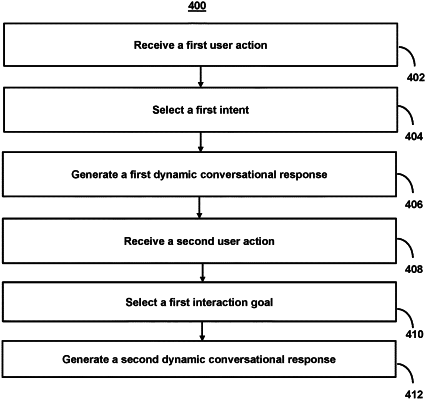| CPC G06F 40/35 (2020.01) [G06F 18/2155 (2023.01); G06N 20/00 (2019.01)] | 20 Claims |

|
1. A system for generating real-time dynamic conversational responses during conversational interactions with messaging applications using machine learning models based on historic intents for a plurality of users and user-specific interactions, the system comprising:
storage circuitry configured to store:
a first machine learning model, wherein the first machine learning model comprises a neural network trained to select a first intent from a plurality of intents based on historic data accumulated prior to conversational interactions; and
a second machine learning model, wherein the second machine learning model is based on the first machine learning model as augmented with a neural network, and wherein the neural network is trained to select a first interaction-specific intent from a plurality of interaction-specific intents based on interaction-specific data for a first user accumulated during the conversational interactions;
control circuitry configured to:
receive, from the first user, a first user action during a conversational interaction with a user interface of a messaging application, wherein the conversational interaction comprises an interactive exchange of text messages between the first user and the messaging application;
determining a static feature, wherein the static feature remains constant during the conversational interaction;
generate a first feature input based on the first user action;
input the first feature input into the first machine learning model to determine the first intent;
receive, from the first user, a second user action during the conversational interaction;
determine a temporal relationship between the first user action and the second user action;
generate a second feature input based on the first user action, the second user action, the static feature, the temporal relationship, and the first intent;
input the second feature input into the second machine learning model to determine the first interaction-specific intent; and
input/output circuitry configured to:
generate for display, at the user interface during the conversational interaction, a first dynamic conversational response based on the first intent, wherein the first dynamic conversational response comprises a first text message; and
generate for display, at the user interface during the conversational interaction, a second dynamic conversational response based on the first interaction-specific intent, wherein the second dynamic conversational response comprises a second text message.
|